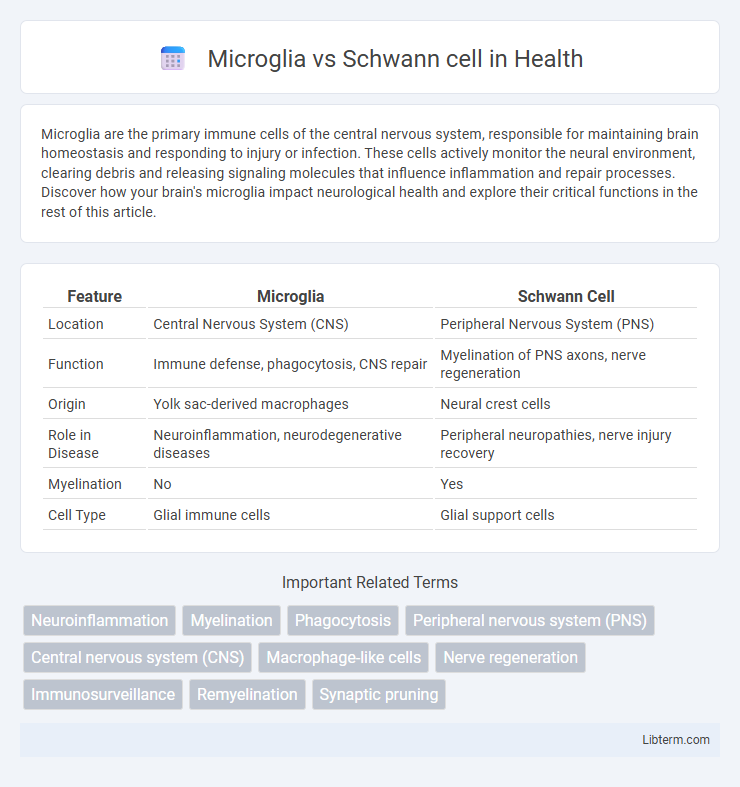Microglia are the primary immune cells of the central nervous system, responsible for maintaining brain homeostasis and responding to injury or infection. These cells actively monitor the neural environment, clearing debris and releasing signaling molecules that influence inflammation and repair processes. Discover how your brain's microglia impact neurological health and explore their critical functions in the rest of this article.
Table of Comparison
| Feature | Microglia | Schwann Cell |
|---|---|---|
| Location | Central Nervous System (CNS) | Peripheral Nervous System (PNS) |
| Function | Immune defense, phagocytosis, CNS repair | Myelination of PNS axons, nerve regeneration |
| Origin | Yolk sac-derived macrophages | Neural crest cells |
| Role in Disease | Neuroinflammation, neurodegenerative diseases | Peripheral neuropathies, nerve injury recovery |
| Myelination | No | Yes |
| Cell Type | Glial immune cells | Glial support cells |
Introduction to Microglia and Schwann Cells
Microglia are the primary immune cells of the central nervous system, responsible for monitoring and maintaining neural homeostasis through phagocytosis and inflammatory responses. Schwann cells are the principal glial cells of the peripheral nervous system, playing a critical role in axonal support, myelination, and nerve regeneration. Both cell types are essential for nervous system function but differ significantly in their location, origin, and specific roles in neural health and repair.
Origin and Developmental Lineage
Microglia originate from yolk sac progenitors during early embryogenesis and migrate into the central nervous system, where they serve as resident immune cells. Schwann cells derive from the neural crest and differentiate along peripheral nerves, playing a crucial role in myelination and nerve regeneration in the peripheral nervous system. Both cell types share glial functions but have distinct embryonic origins and developmental pathways critical for their specialized roles in neural tissue.
Morphological Differences
Microglia are small, highly branched cells with a compact cell body and fine, ramified processes, primarily found in the central nervous system. Schwann cells exhibit an elongated, spindle-shaped morphology with a large, flattened cell body, wrapping around axons in the peripheral nervous system to form myelin sheaths. The distinct morphological characteristics reflect their specialized functions in neural support and immune response within different nervous system compartments.
Primary Functions in the Nervous System
Microglia serve as the primary immune defense in the central nervous system (CNS), responsible for phagocytosis of pathogens and damaged neurons, as well as modulating neuroinflammation. Schwann cells are essential for the peripheral nervous system (PNS), providing myelination of axons to enhance electrical signal transmission and facilitating nerve regeneration. Both cell types maintain neuronal health but operate in distinct nervous system regions with specialized roles in immune response and support.
Role in Neural Injury and Repair
Microglia serve as the primary immune cells in the central nervous system, rapidly responding to neural injury by clearing debris and releasing inflammatory cytokines that modulate repair. Schwann cells, located in the peripheral nervous system, promote axonal regeneration by forming myelin sheaths and secreting growth factors that support nerve repair. Both cell types coordinate to restore neural function, with microglia mediating inflammation-related cleanup and Schwann cells facilitating regrowth and remyelination.
Interaction with Other Neural Cells
Microglia interact closely with neurons and astrocytes to regulate synaptic pruning, neuroinflammation, and tissue repair within the central nervous system (CNS). Schwann cells primarily support peripheral nerve regeneration by myelinating axons and interacting with neurons and macrophages to facilitate debris clearance after injury. Both cell types influence neural plasticity by modulating the cellular environment, but microglia operate mainly within the CNS while Schwann cells function in the peripheral nervous system (PNS).
Immune Functions and Inflammatory Responses
Microglia serve as the primary immune cells of the central nervous system, actively detecting pathogens and clearing cellular debris through phagocytosis, while Schwann cells support immune responses in the peripheral nervous system by modulating inflammation and facilitating nerve regeneration. Microglia release pro-inflammatory cytokines such as IL-1b and TNF-a during neuroinflammatory conditions, whereas Schwann cells produce chemokines like MCP-1 to recruit macrophages and promote tissue repair. Both cell types play crucial roles in maintaining neural homeostasis but differ in their immune activation mechanisms and anatomical localizations.
Clinical Significance and Diseases
Microglia act as the primary immune cells in the central nervous system, playing a crucial role in neuroinflammation and neurodegenerative diseases such as Alzheimer's, Parkinson's, and multiple sclerosis. Schwann cells are essential in peripheral nerve regeneration and are involved in diseases like Charcot-Marie-Tooth disease and peripheral neuropathies. Dysregulation of microglial activation contributes to chronic neuroinflammation, while Schwann cell dysfunction impairs nerve repair and myelination, impacting clinical outcomes in nervous system disorders.
Recent Research and Discoveries
Recent research highlights distinct roles of microglia and Schwann cells in neural repair, with microglia primarily orchestrating immune responses in the central nervous system while Schwann cells promote peripheral nerve regeneration through myelination and axonal support. Advanced imaging and single-cell RNA sequencing techniques have revealed microglial heterogeneity and their involvement in neuroinflammation, neurodegeneration, and synaptic remodeling. Novel discoveries emphasize Schwann cells' plasticity in converting to repair phenotypes, facilitating remyelination and functional recovery after nerve injury.
Future Directions in Therapeutic Applications
Emerging research highlights microglia as pivotal targets in neurodegenerative disease therapies due to their role in CNS immune responses, while Schwann cells are crucial for peripheral nerve regeneration and repair methods. Advances in gene editing and cell reprogramming aim to enhance microglial modulation to mitigate neuroinflammation and promote neural plasticity. Schwann cell transplantation and biomaterial scaffolds are being optimized to improve functional recovery in peripheral neuropathies, presenting promising therapeutic avenues.
Microglia Infographic

 libterm.com
libterm.com